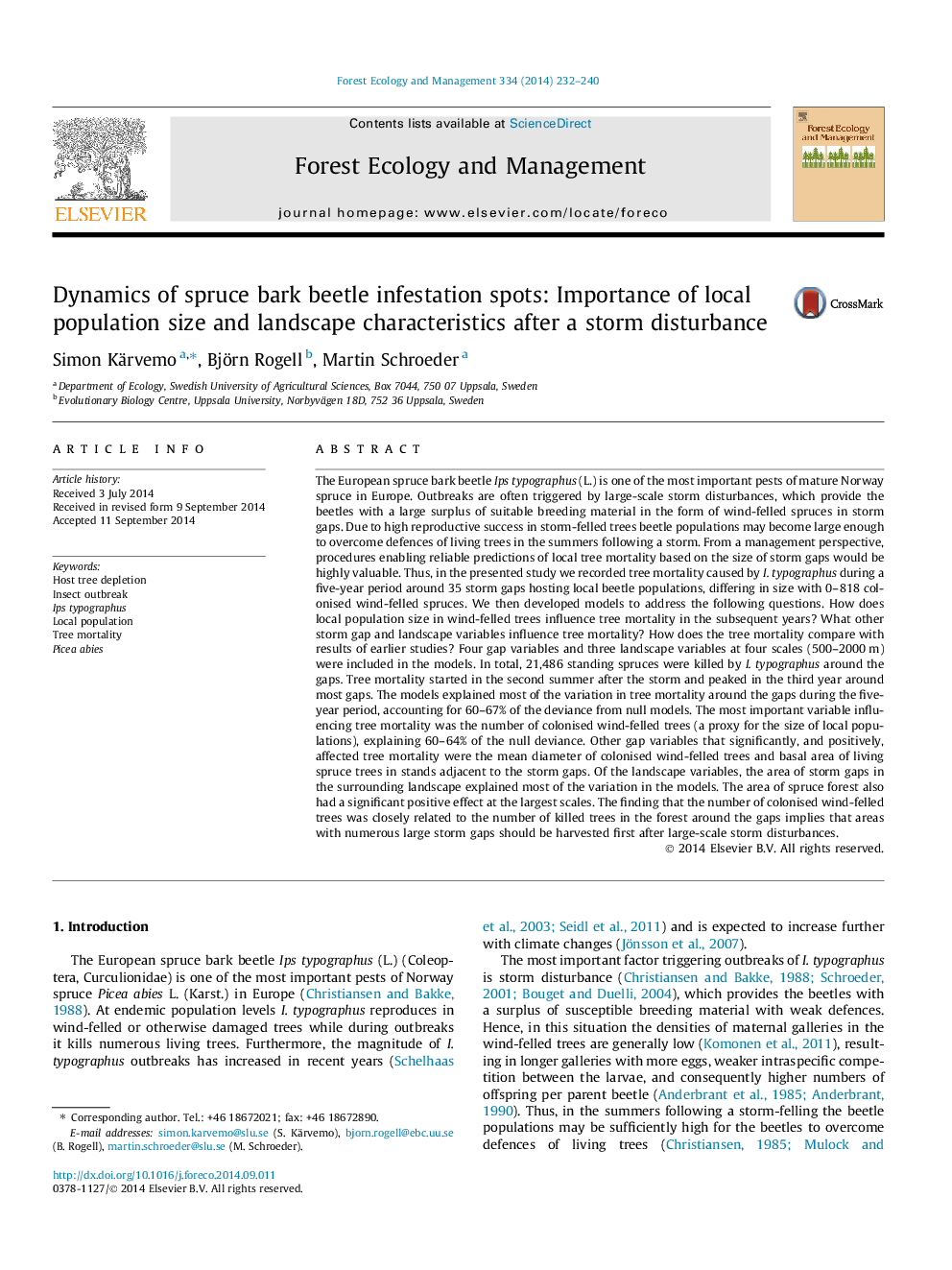| کد مقاله | کد نشریه | سال انتشار | مقاله انگلیسی | نسخه تمام متن |
|---|---|---|---|---|
| 6543152 | 159186 | 2014 | 9 صفحه PDF | دانلود رایگان |
عنوان انگلیسی مقاله ISI
Dynamics of spruce bark beetle infestation spots: Importance of local population size and landscape characteristics after a storm disturbance
ترجمه فارسی عنوان
دینامیک نقاط آلودگی سوسک جو: اهمیت اندازه جمعیت محلی و ویژگی های چشم انداز پس از اختلال طوفان
دانلود مقاله + سفارش ترجمه
دانلود مقاله ISI انگلیسی
رایگان برای ایرانیان
کلمات کلیدی
موضوعات مرتبط
علوم زیستی و بیوفناوری
علوم کشاورزی و بیولوژیک
بوم شناسی، تکامل، رفتار و سامانه شناسی
چکیده انگلیسی
The European spruce bark beetle Ips typographus (L.) is one of the most important pests of mature Norway spruce in Europe. Outbreaks are often triggered by large-scale storm disturbances, which provide the beetles with a large surplus of suitable breeding material in the form of wind-felled spruces in storm gaps. Due to high reproductive success in storm-felled trees beetle populations may become large enough to overcome defences of living trees in the summers following a storm. From a management perspective, procedures enabling reliable predictions of local tree mortality based on the size of storm gaps would be highly valuable. Thus, in the presented study we recorded tree mortality caused by I. typographus during a five-year period around 35 storm gaps hosting local beetle populations, differing in size with 0-818 colonised wind-felled spruces. We then developed models to address the following questions. How does local population size in wind-felled trees influence tree mortality in the subsequent years? What other storm gap and landscape variables influence tree mortality? How does the tree mortality compare with results of earlier studies? Four gap variables and three landscape variables at four scales (500-2000Â m) were included in the models. In total, 21,486 standing spruces were killed by I. typographus around the gaps. Tree mortality started in the second summer after the storm and peaked in the third year around most gaps. The models explained most of the variation in tree mortality around the gaps during the five-year period, accounting for 60-67% of the deviance from null models. The most important variable influencing tree mortality was the number of colonised wind-felled trees (a proxy for the size of local populations), explaining 60-64% of the null deviance. Other gap variables that significantly, and positively, affected tree mortality were the mean diameter of colonised wind-felled trees and basal area of living spruce trees in stands adjacent to the storm gaps. Of the landscape variables, the area of storm gaps in the surrounding landscape explained most of the variation in the models. The area of spruce forest also had a significant positive effect at the largest scales. The finding that the number of colonised wind-felled trees was closely related to the number of killed trees in the forest around the gaps implies that areas with numerous large storm gaps should be harvested first after large-scale storm disturbances.
ناشر
Database: Elsevier - ScienceDirect (ساینس دایرکت)
Journal: Forest Ecology and Management - Volume 334, 15 December 2014, Pages 232-240
Journal: Forest Ecology and Management - Volume 334, 15 December 2014, Pages 232-240
نویسندگان
Simon Kärvemo, Björn Rogell, Martin Schroeder,
